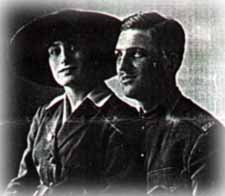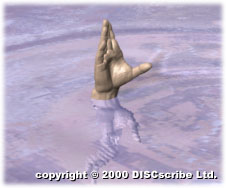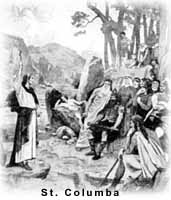
|
Part One by Andrew Morrison
My grandmother was a very rational lady, by no means a superstitious country girl. Her father was a minister of great repute, Moderator elect of the Church of Scotland when he died, and Allison herself won the prize for Logic at Edinburgh University, And yet she told me that she knew, when she first caught sight of my grandfather in a crowd, that she would marry him, because she had seen him before in her dreams. She also told me that a few years earlier, during the First World War, my grandfather received a visit one night from his older brother who was serving in a different regiment at the front. The brother, who had an extraordinary reputation for bravery and invulnerability among his men, had come to say good-bye, because he knew he would be killed the next day. And so he was. I asked my grandmother what she made of that, and she was mildly scornful. "That was the second sight," she said. "Many people from the Islands had it." She did not dispute its existence, merely implying that having it was a sign of not being quite civilized. Similarly, Margaret Fay Shaw, in the introduction to her "Folksongs and Folklore of South Uist" (Oxford University Press, 1955), writes:
Second sight, which is the ability to foresee what is to happen, is well known, and the possessor is never envied. There is no doubt that it exists and that it is inherited. In most instances the seer foresaw tragedy, as in the instance of the girl who saw seaweed about the necks of two young men at a dance at Garrynamonie, and they were drowned together soon after...There are well-attested stories of this foresight and the disasters which followed which I personally fully believe."
And indeed she goes on to give other examples, including one experience she herself had. There is of course nothing new about this sort of thing. Anyone interested in getting beyond the quaint, feel-good, tree-hugging books about Celtic What is unquestionable is that it was a central element in the Celtic saints' own understanding of their spirituality. Adamnan's Life of Saint Columha (written in the Hebrides some 1300 years ago) is divided into three sections, Prophecies, Miracles and Visions. Raghnall MacilleDhuibh, writing in the West Highland Free Press (August 2,1996) gives us a detailed account of the 99 Prophecies, 44 of which he believes can be explained rationally, and "55 which seem to provide evidence of genuine psychic power." Raghnall, by the way, shows himself no uncritical admirer of the Saint, referring to him as "a rural gangland leader" in his early life, and describing Adamnan's description of him as a "simple and innocent man" as "deliberate propaganda". Ragnail concludes: 55 of the 99 prophecies are full of solid evidence that Calum Cille (i.e. Columba) had the second sight; the other 44 suggest that he and his supporters were willing to misuse the gift in the interests of gaining and retaining power. If we believe in second sight at all, then we must believe that this man had it, and we may wish to believe that second sight alone accounts for all 99 prophecies; if we do not believe in it, then we have seen some excellent examples of how cleverness can lead to chicanery and chicanery to folklore.
In other words, he is suggesting that you can't have it both ways. Too many books on the Celtic Church present only those carefully selected features which the authors believe will resonate with a modem audience, (for instance, respect for women and the environment, a preference for a simple communal or solitary life over the artificial structures of the church, and an emphasis on the poetical dimension to spirituality). They conveniently ignore what will not resonate, and while nothing was more important about Columba for Adamnan than his second sight, nothing is less likely to resonate with us today. Put simply, most books that purport to be about something called Celtic Christianity appear to dodge this central issue altogether. All right, what do we have so far? We have a strange, paranormal faculty apparently taken for granted in the Hebrides for hundreds of years and yet virtually unknown in the outside world. At this point I think we need to ask certain questions. Is it real? Does it occur only or just disproportionately in the islands, and if so, why? What causes it? Would acceptance of it require one to buy into the rest of the spirit worldview of the islanders? Is the seer necessarily a holy person, or even a Christian? How does it relate to “the gift of Prophecy? Can a disaster once foreseen be averted? And generally, what's the point of it all, what can we learn from it? Meet the author, Andrew Morrison
Celtic Spirituality and the Gift of Second Sight Main Page |
Thursday, December 26th, 2019
Attention visitors: Tartans.com is back. Please note that this is a snapshot of the site as it existed nearly 20 years ago and you may encounter broken links; we are still combing through the site and correcting those as we find them. Please also note that some sections are currently not functional, primarily the discussion forums/clan chat boards.
|
** HOME - First Time Visitors - Glossary - - Contact Us ** Awards | Bibliography | Clan Calendar | Clan Chat | Clan Finder | History | Famous Scots | Genealogy | Great Hall of the Clans | Links | News and Features | Scots on the Net | Search | Site Map The Gathering of the Clans
Copyright 1995- Tartans.com - All Rights Reserved. |
 before moving south and becoming one of the first female lawyers to be called to the English Bar.
before moving south and becoming one of the first female lawyers to be called to the English Bar.  Christianity will have to confront this phenomenon sooner or later and determine where he or she stands on it.
Christianity will have to confront this phenomenon sooner or later and determine where he or she stands on it.  Either you accept second sight as a central feature of an admired Celtic Christianity, or you should dismiss the whole thing as fraud.
Either you accept second sight as a central feature of an admired Celtic Christianity, or you should dismiss the whole thing as fraud.